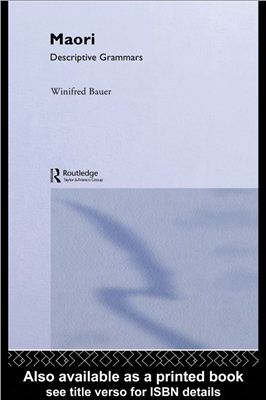Routledge, 1993. - 640 p.
ISBN-10: 0415022541
ISBN-13: 978-0415022545
This descriptive grammar provides a uniquely comprehensive description of Maori. Today the language is under threat and it seems likely that the Maori of the future will differ quite considerably from the Maori of the past.
This book provides a uniquely comprehensive linguistic description of Maori, the East Polynesian language of the indigenous people of New Zealand. Today the language is under threat and it seems likely that the Maori of the future will differ quite considerably from the Maori of the past. With few inflections Maori is readily approached by linguists. It has an elaborate system for the expression of possession, and while superficially an accusative language, it shows various traces of ergativity. The area of transitivity in particular provides a number of interesting theoretical problems and constructions unusual outside the Polynesian family.
Winifred Bauer offers a wide-ranging and detailed description of the structure of the language, covering syntax, morphology and phonology. It is based on written narrative texts and data elicited from older native-speaking consultants, and also includes many comments on current changes in usage.
This descriptive grammar, which is illustrated with a wealth of examples, will be of interest to both linguistic theoreticians and descriptive linguists, including language typologists, and provides a resource for the study and resucitation of the Maori language.
Winifred Bauer has been involved in linguistic research into the Maori language for twenty years, and is currently an Honorary Research Fellow in the Linguistics department of the Victoria University of Wellington, New Zealand.
ISBN-10: 0415022541
ISBN-13: 978-0415022545
This descriptive grammar provides a uniquely comprehensive description of Maori. Today the language is under threat and it seems likely that the Maori of the future will differ quite considerably from the Maori of the past.
This book provides a uniquely comprehensive linguistic description of Maori, the East Polynesian language of the indigenous people of New Zealand. Today the language is under threat and it seems likely that the Maori of the future will differ quite considerably from the Maori of the past. With few inflections Maori is readily approached by linguists. It has an elaborate system for the expression of possession, and while superficially an accusative language, it shows various traces of ergativity. The area of transitivity in particular provides a number of interesting theoretical problems and constructions unusual outside the Polynesian family.
Winifred Bauer offers a wide-ranging and detailed description of the structure of the language, covering syntax, morphology and phonology. It is based on written narrative texts and data elicited from older native-speaking consultants, and also includes many comments on current changes in usage.
This descriptive grammar, which is illustrated with a wealth of examples, will be of interest to both linguistic theoreticians and descriptive linguists, including language typologists, and provides a resource for the study and resucitation of the Maori language.
Winifred Bauer has been involved in linguistic research into the Maori language for twenty years, and is currently an Honorary Research Fellow in the Linguistics department of the Victoria University of Wellington, New Zealand.

